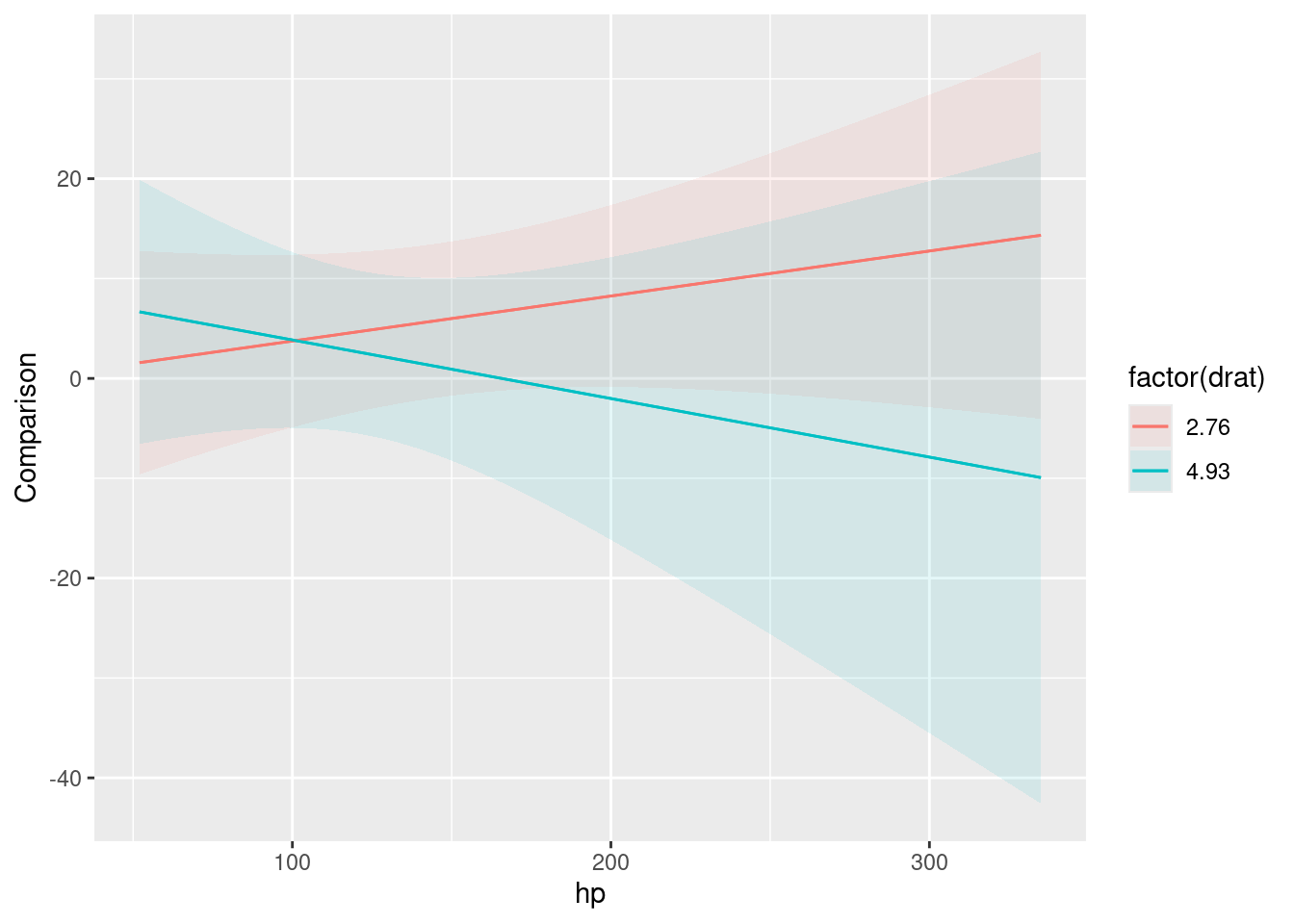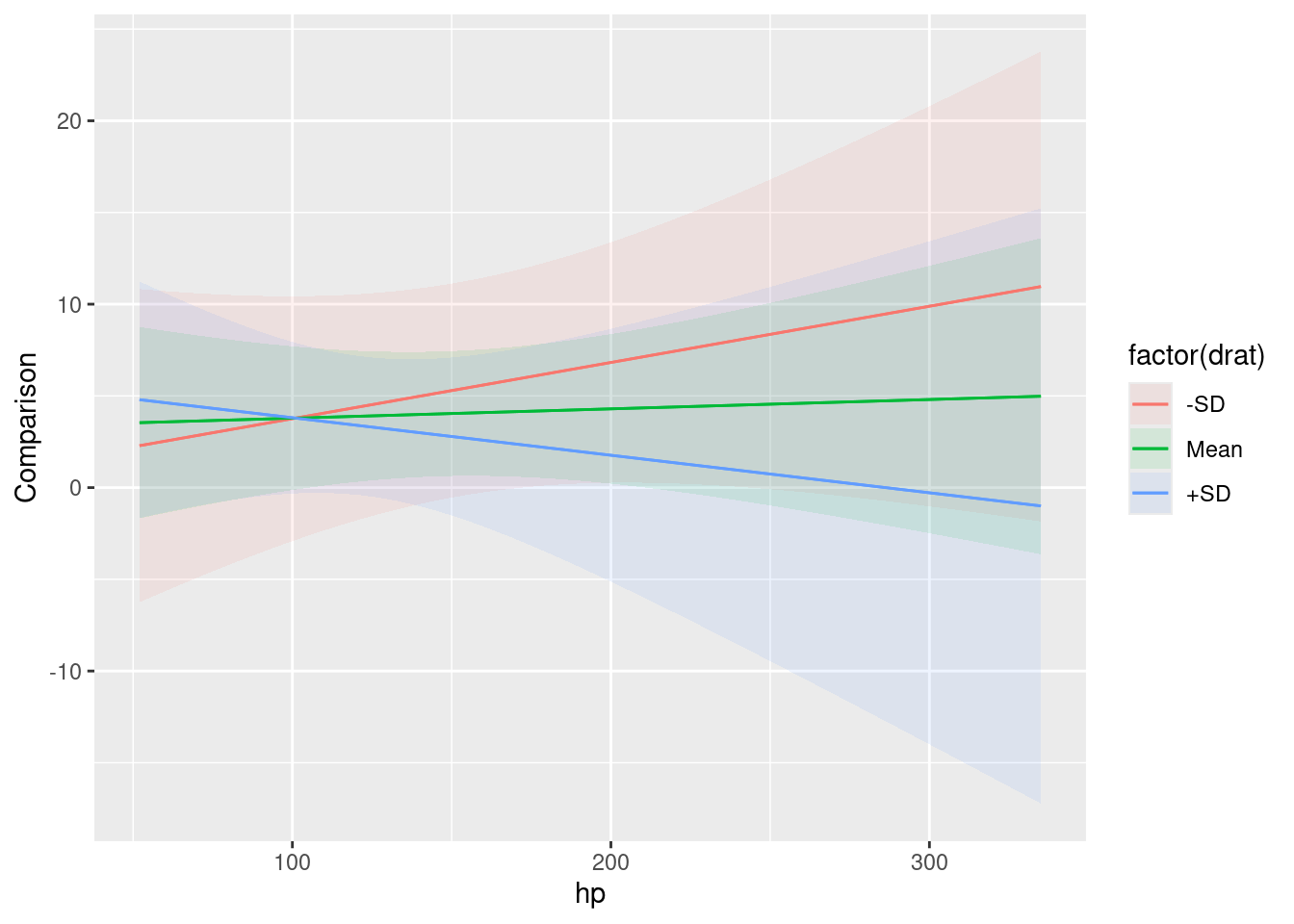model
|
Model object
|
variables
|
Name of the variable whose contrast we want to plot on the y-axis.
|
condition
|
Conditional slopes
-
Character vector (max length 4): Names of the predictors to display.
-
Named list (max length 4): List names correspond to predictors. List elements can be:
-
Numeric vector
-
Function which returns a numeric vector or a set of unique categorical values
-
Shortcut strings for common reference values: "minmax", "quartile", "threenum"
-
1: x-axis. 2: color/shape. 3: facet (wrap if no fourth variable, otherwise cols of grid). 4: facet (rows of grid).
-
Numeric variables in positions 2 and 3 are summarized by Tukey’s five numbers ?stats::fivenum.
|
by
|
Aggregate unit-level estimates (aka, marginalize, average over). Valid inputs:
-
FALSE: return the original unit-level estimates.
-
TRUE: aggregate estimates for each term.
-
Character vector of column names in newdata or in the data frame produced by calling the function without the by argument.
-
Data frame with a by column of group labels, and merging columns shared by newdata or the data frame produced by calling the same function without the by argument.
-
See examples below.
-
For more complex aggregations, you can use the FUN argument of the hypotheses() function. See that function’s documentation and the Hypothesis Test vignettes on the marginaleffects website.
|
newdata
|
When newdata is NULL, the grid is determined by the condition argument. When newdata is not NULL, the argument behaves in the same way as in the comparisons() function.
|
type
|
string indicates the type (scale) of the predictions used to compute contrasts or slopes. This can differ based on the model type, but will typically be a string such as: "response", "link", "probs", or "zero". When an unsupported string is entered, the model-specific list of acceptable values is returned in an error message. When type is NULL, the first entry in the error message is used by default.
|
vcov
|
Type of uncertainty estimates to report (e.g., for robust standard errors). Acceptable values:
-
FALSE: Do not compute standard errors. This can speed up computation considerably.
-
TRUE: Unit-level standard errors using the default vcov(model) variance-covariance matrix.
-
String which indicates the kind of uncertainty estimates to return.
-
Heteroskedasticity-consistent: “HC”, “HC0”, “HC1”, “HC2”, “HC3”, “HC4”, “HC4m”, “HC5”. See ?sandwich::vcovHC
-
Heteroskedasticity and autocorrelation consistent: “HAC”
-
Mixed-Models degrees of freedom: "satterthwaite", "kenward-roger"
-
Other: “NeweyWest”, “KernHAC”, “OPG”. See the sandwich package documentation.
-
One-sided formula which indicates the name of cluster variables (e.g., ~unit_id). This formula is passed to the cluster argument of the sandwich::vcovCL function.
-
Square covariance matrix
-
Function which returns a covariance matrix (e.g., stats::vcov(model))
|
conf_level
|
numeric value between 0 and 1. Confidence level to use to build a confidence interval.
|
wts
|
logical, string or numeric: weights to use when computing average predictions, contrasts or slopes. These weights only affect the averaging in avg_*() or with the by argument, and not unit-level estimates. See ?weighted.mean
-
string: column name of the weights variable in newdata. When supplying a column name to wts, it is recommended to supply the original data (including the weights variable) explicitly to newdata.
-
numeric: vector of length equal to the number of rows in the original data or in newdata (if supplied).
-
FALSE: Equal weights.
-
TRUE: Extract weights from the fitted object with insight::find_weights() and use them when taking weighted averages of estimates. Warning: newdata=datagrid() returns a single average weight, which is equivalent to using wts=FALSE
|
comparison
|
How should pairs of predictions be compared? Difference, ratio, odds ratio, or user-defined functions.
-
string: shortcuts to common contrast functions.
-
Supported shortcuts strings: difference, differenceavg, differenceavgwts, dydx, eyex, eydx, dyex, dydxavg, eyexavg, eydxavg, dyexavg, dydxavgwts, eyexavgwts, eydxavgwts, dyexavgwts, ratio, ratioavg, ratioavgwts, lnratio, lnratioavg, lnratioavgwts, lnor, lnoravg, lnoravgwts, lift, liftavg, liftavgwts, expdydx, expdydxavg, expdydxavgwts
-
See the Comparisons section below for definitions of each transformation.
-
function: accept two equal-length numeric vectors of adjusted predictions (hi and lo) and returns a vector of contrasts of the same length, or a unique numeric value.
|
transform
|
string or function. Transformation applied to unit-level estimates and confidence intervals just before the function returns results. Functions must accept a vector and return a vector of the same length. Support string shortcuts: "exp", "ln"
|
rug
|
TRUE displays tick marks on the axes to mark the distribution of raw data.
|
gray
|
FALSE grayscale or color plot
|
draw
|
TRUE returns a ggplot2 plot. FALSE returns a data.frame of the underlying data.
|
…
|
Additional arguments are passed to the predict() method supplied by the modeling package.These arguments are particularly useful for mixed-effects or bayesian models (see the online vignettes on the marginaleffects website). Available arguments can vary from model to model, depending on the range of supported arguments by each modeling package. See the "Model-Specific Arguments" section of the ?slopes documentation for a non-exhaustive list of available arguments.
|




